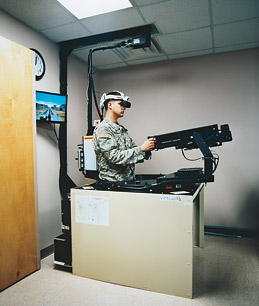
U.S. Army specialist Ethan McCord was one of the first on the scene when a group of suspected insurgents was blown up on a Baghdad street in 2007, hit by 30-mm bursts from an Apache helicopter. “The top of one guy’s head was completely off,” he recalls. “Another guy was ripped open from groin to neck. A third had lost a leg … Their insides were out and exposed. I’d never seen anything like this before.” Then McCord heard a child crying from a black minivan caught in the barrage. Inside, he found a frightened and wounded girl, perhaps 4. Next to her was a boy of 7 or so, soaked in blood. Their father, McCord says, “was slumped over on his side, like he was trying to protect the children, but he was just destroyed.” McCord couldn’t look away from the kids. “I started seeing images of my own two children back home in Kansas.” Ethan McCord’s mind and thousands like his are the U.S. Army’s third front. While its combat troops fight two wars, its mental-health professionals are waging a battle to save soldiers’ sanity when they come back, one that will cost billions long after combat ends in Baghdad and Kabul. It is a high-intensity conflict: Army troops, TIME has learned, are seeking mental help more than 100,000 times a month. That figure reflects a growth of more than 75% from the final months of 2006 to the final months of ’09, according to Army data. Army Lieut. General Eric Schoomaker, the surgeon general who oversees the mental and physical well-being of the nation’s soldiers, concedes he doesn’t have the doctors and therapists he needs. “We’re in uncharted territory in respect to the strain on the force,” Schoomaker said recently. Translation: he needs help. According to the Army’s estimates of its needs, 414 psychiatrists are 20% fewer than Schoomaker should have. A study released by the Army on July 29 concluded that “numerous critical shortages of care providers including behavioral health” personnel are hurting its efforts to curb suicides. “The Army has been criminally negligent,” says Captain Peter Linnerooth, an Army psychologist for nearly five years until 2008, who notes that the service has had a difficult time finding psychiatrists to care for combat vets, which puts even more pressure–“and way too much burnout”–on those who stay. Interviews with dozens of mental-health experts at Army bases tell a similar story. Even though the Army mental-health corps has increased about 60% since 9/11, demand is growing even faster. One anonymous mental-health professional told researchers last year that he spends a quarter of his time on “really sick people who never should have been let in [the military] to begin with.” During the past year, indeed, it has become clear that a shortage of mental-health care can be nearly as dangerous to troops as any enemy. Last November, when Army psychiatrist Major Nidal Hasan allegedly gunned down 13 people at Fort Hood, Texas, it forced the Army to ask some hard questions. Did supervisors overlook Hasan’s poor performance and alarming ideology because they are desperate for psychiatrists?